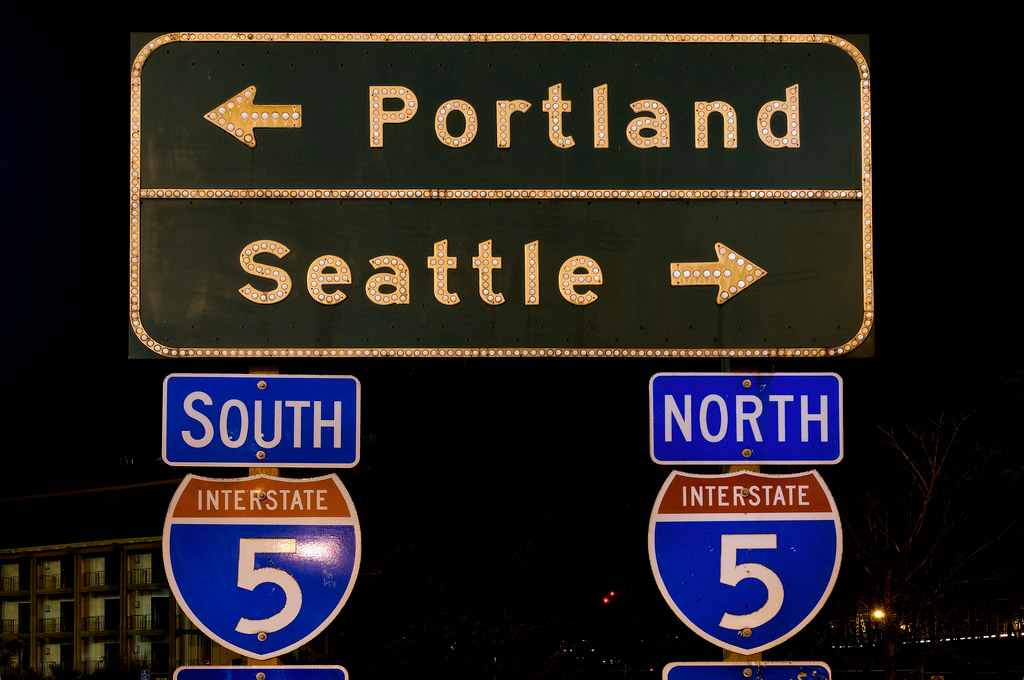How Portland Lost the Battle for Cascadia: Process v. Progress
Portland is currently an afterthought in Cascadia conversations. If the Rose City continues to wait for an invite to the table, then Seattle and Vancouver, B.C. will simply move ahead without us.
In 1950, Seattle and Portland had similar economic prospects. Both had established themselves as regional hubs but neither had become the dominant economic capital of the Pacific Northwest. Seventy years later, Seattle outpaced Portland across the board. The Emerald City leaned into their universities, their international neighbors, and their business community to become the "go-ahead" city. Portland, content to "keep things as they are," watched Seattle attract more businesses, more innovators, and more opportunities for its residents.
One case study makes abundantly clear that where Seattle sought progress, Portland relied on process. As outlined by Carl Abbott, when both cities aimed to host a world's fair, they took two very different approaches that led to wildly different outcomes. Seattle, "project-centered, entrepreneurial, and expansive," rallied its business community, civic sector, and public sector behind their fair. Aspiring to match the likes of Chicago and Philadelphia, Seattle planners and stakeholders were not shy about establishing the city as a premier destination in terms of tourism and economic development. That vision inspired strong business leadership and political backing, a collaboration that justified robust investment from the state ($7.5m), the federal government ($9m), and the city ($15m).
With that impressive money in tow, Seattle had no trouble receiving an official designation from the Bureau of International Expositions as a world's fair. With that impressive endorsement, more public and private interests flocked to the cause. Walt Disney, the National Academy of Sciences and many other institutions of the day found a way to be a part of the fair. Ultimately, nearly 10 million paid visitors stopped by. In the wake of the fair, Seattle residents continued to benefit from a new science museum, renovated auditorium, and convention facilities. Perhaps more importantly, Seattle had established itself as the Northwest's only national city.
Portland similarly pursued an exposition but set no high goals to inspire participation from around the city and country. In fact, "Portlanders viewed the expansion of economic networks as irrelevant or even threatening to stable commercial relationships." Fearful of change and reliant on process, the planning effort in the Rose City was cautious and highly localized. Whereas Seattle invited the world to participate in a celebration of progress, Portland modeled its exposition on local "pioneer days."
Infighting among Portland neighborhoods and squabbles in Salem resulted in a shabby convention. Governor Hatfield battled with a state commission. Portlanders created their own commission, which then battled with the mayor. The City Council refused to follow guidance from expert planners. All of these skirmishes relegated the convention to a plot outside of downtown and forced it to operate on a shoestring budget, including just $2.6m from the state. Ultimately, fewer than one million people attended; organizers had hoped for five to seven million visits.
In the decades since, progress and process have continued to define Seattle and Portland, respectively. At this point, Portland cannot catch Seattle. Sure the Timbers may beat the Sounders, but Seattle's economic might and progress-oriented political and business class will leave Portland looking up to its northern neighbor. The best Portland can hope for its to become a bigger planet in Seattle's orbit by helping foster a regional approach to governance, economic development, and transportation.
I'm not betting against Portland, I'm just applying basic economics that suggest the city's path best requires more closely aligning with Seattle. Where a dominant city emerges in a region, a rival does not eclipse it but must instead learn how to complement and benefit from the growth of the main city. We live in an era of mega-regions and the Cascadia Corridor has the potential to be just that.
Many influential Washington and Canadian leaders already understand that essential economic reality. In turn, Prime Minister Trudeau and Governor Inslee have explored ways to forge closer economic and cultural ties between Vancouver, B.C. and Seattle. They've managed to overcome barriers such as border regulations, differences in political processes, and myriad stakeholders. The key to their success -- a shared, bold vision and a commitment to progress.
Portland is currently an afterthought in Cascadia conversations. If the Rose City continues to wait for an invite to the table, then Seattle and Vancouver, B.C. will simply move ahead without us. They'll move forward on high-speed rail, economic integration, and research collaborations, while Portlanders debate whether a bridge should have one or two bike lanes.
Economic evolution is underway and will continue regardless of whether Portlanders embrace or attempt to resist it. Unlike in the 1950s and 1960s, we ought to take on the challenge of distributing progress rather than trying to design a perfect process. Keeping things as they are should not be an option.
Kevin Frazier runs the Oregon Way between grad school classes. Originally from Washington County, Kevin worked in the Oregon state government in several capacities before working on tech policy through the private and nonprofit sectors.
"Portland Left Seattle Right" by Curtis Gregory Perry is licensed under CC BY-NC-SA 2.0





I've really enjoyed and appreciated the perspectives put forward by The Oregon Way so far, but I'm struggling with the message here. It lacks any specificity for the argument being made, and relies on a decades old example and a clumsy attempt at caricaturing Portland's support for biking to make its point. Meanwhile, Oregon was an equal funder in the recent report studying the viability of high-speed rail. Oregon boasts major research universities which collaborate extensively with partners in Seattle and Vancouver. And all three cities are investing in bike lanes and other ways to improve mobility while curbing carbon emissions. It's easy to wonder if the author has lived in Portland or Oregon enough to bring any meaningful insights to this conversation.